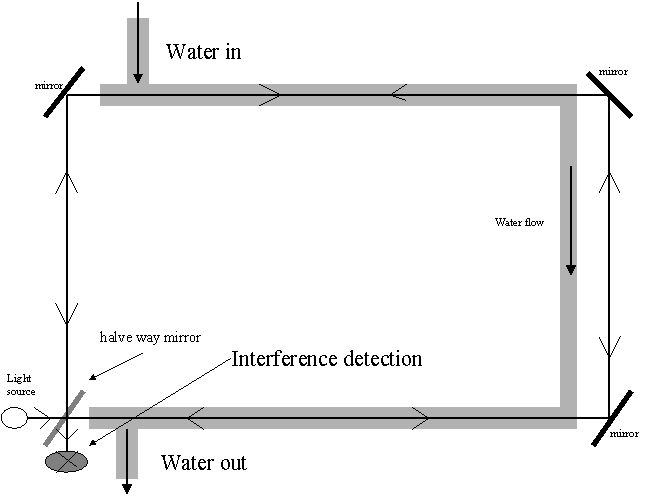The experiment of Fizeau
When you are interested in physics you must read “Unbelievable“!
Fresnel introduced the drag factor to explain or rather to compensate for the fact that the earth seemed to be at rest in the ether. Obviously they were looking for proof of the absolute ether. If there was no ether it would be inexplicable how light, fields and forces like gravity, electrostatic and magnetic fields could be propagated through space. The urge to prove the existence of the absolute ether was imminent. Without the ether physical characteristics, like the transportation of light in vacuum, became inconceivable and mysterious. Proving the existence of Fresnel’s drag factor was necessary. Demonstrating the drag factor was not easy because of the extreme velocity of the speed of light with approx. 300,000 km/s.
In 1851 Fizeau devised an experiment with unknown accuracy that was able to measure Fresnel’s assumed drag factor.

Figure 6. The experiment of Fizeau.
The light of source is divided up into two beams. One beam goes with the flow of water and the other beam against the flow. When the light in the water is dragged the light traveling against the water flow will need more time to travel through the tubes than if the light goes with the flow. This is comparable with the time difference a swimmer needs to swim with or against the current. The difficulty here is that the speed of the “swimmer” is so high that it takes him only 1/100,000,000 of a second to finish. The difference between with or against the flow is even much smaller.
Light is vibration with a very short wavelength. Vibrations are able to fortify or tone down each other when they meet. The difference between extinguishing and fortifying, a bright and a dark line in the interference pattern, is about 1/40 of a millionth of a meter. The interference of light is characterized bright and dark stripes: the interference lines. The whole picture of dark and light stripes is called the interference pattern.
The experiment of Fizeau is called an optical interferometer and was devised to measure very small differences in time or distance. The drag coefficient of Fresnel, ![]() , implies in the experiment of Fizeau a drag of
, implies in the experiment of Fizeau a drag of ![]() interference lines (λ the wavelength of the light, v the flow speed of the water and L the length). For the derivation of this formula see the next chapter. Fizeau registered during his experiment a shift of δ=0.23 in the interference lines; which implicates a drag factor f=0.48; the empirical value. The theoretical value of the drag factor is calculated with the formulas
interference lines (λ the wavelength of the light, v the flow speed of the water and L the length). For the derivation of this formula see the next chapter. Fizeau registered during his experiment a shift of δ=0.23 in the interference lines; which implicates a drag factor f=0.48; the empirical value. The theoretical value of the drag factor is calculated with the formulas![]() and
and ![]() and is calculated at f=0.43. So within an error of approx. 10%, the experiment of Fizeau confirmed Fresnel’s drag factor.
and is calculated at f=0.43. So within an error of approx. 10%, the experiment of Fizeau confirmed Fresnel’s drag factor.
Next chapter: The experiment of Fizeau and the dragged ether





